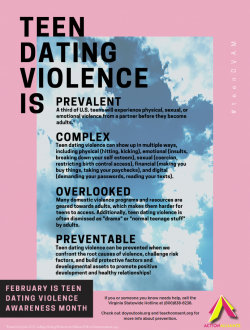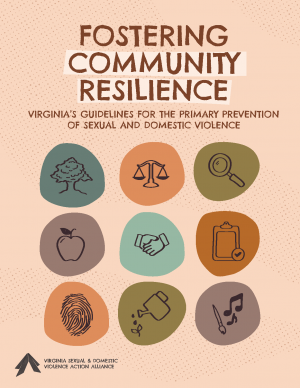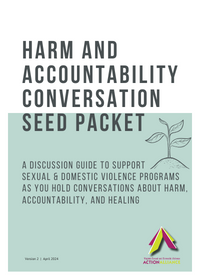Resources Library: Prevention
Start a Search:
February is Teen Dating Violence Awareness Month

February is Teen Dating Violence Awareness month. This poster outlines some common misconceptions about teen dating violence as well as offering some action items toward preventing it. For more information, see doyoutools.org and teachconsent.org.
Fostering Community Resilience: Virginia’s Guidelines for the Primary Prevention of Sexual and Domestic Violence

The purpose of Fostering Community Resilience: Virginia’s Guidelines for the Primary Prevention of Sexual and Domestic Violence is to assist local communities in creating primary prevention strategies that focus on identifying and dismantling the root causes of sexual and domestic violence. The Guidelines have been built on the foundations of two core concepts: social justice principles and public health models.
Visit https://guidelines.vsdvalliance.org/ for more information about each guideline, in addition to resources and tools for prevention program development. To download the PDF of the guidelines, click this link.
Published by the Virginia Sexual & Domestic Violence Action Alliance, 2022. 34 pages.
From Hurt to Hope: A Child Sexual Abuse/Assault Advocacy Guide
From Hurt to Hope: A Child Sexual Abuse/Assault Advocacy Guide: A guide from WCSAP (Washington Coalition of Sexual Assault Programs) that provides foundational knowledge of best practices for advocates working with youth and their caregivers. The guide includes an overview of Child sexual Abuse/assault, general advocacy, medical advocacy, legal advocacy, system's coordination, information and referral, and crisis intervention.
Geographic Location and Type of Family and Intimate Partner Homicide in Virginia 1999-2008
This report presents information about the geopgraphic distribution of family and intimate partner homicide types among Virginia's five Health Planning Regions.
Published: February 2012
Data Included: 1999-2008
This report is a product of Virginia Department of Health's Office of the Chief Medical Examiner's Family & Intimate Partner Homicide Surveillance Project. For more information about this project, visit: http://www.vdh.state.va.us/medExam/familyintimatepartnerviolencehomicidesurveillance.htm
Harm and Accountability Conversation Seed Packet: A Discussion Guide to Support Sexual & Domestic Violence Programs as You Hold Conversations About Harm, Accountability, and Healing

The Harm and Accountability Conversation Seed Packet is a guide to help people working in sexual and domestic violence programs begin to think more broadly about what accountability can and should look like, not only after harm is committed, but also in all aspects of their lives: our relationships, families, workplaces, and communities.
The 95-page document includes 17 exercises and concrete steps for folks working in sexual and domestic violence agencies who want to expand their knowledge and practice of effective accountability.
Examples of activities in the discussion guide include:
• Responding to harm caused by individuals vs. systems
• How shame can block accountability
• What is the “victim/perpetrator binary” and how does it impede our work?
• Accountability and punishment Venn diagram
• What are the obstacles to accountability and how to overcome them?
• How to give a genuine apology
• Healing and accountability wheel
The discussion guide is designed to be a toolkit for holding conversations in your workplace, communities, and families. It was written to spark discussions about what paths exist for promoting accountability and how we can practice it in our own lives to model it for our friends, families, coworkers, and communities.
The guide asks us to consider what systems for supporting accountability currently exist, and to imagine new ways of approaching our responses to harm…approaches that not only reinforce accountability but also strengthen connection and healing.

